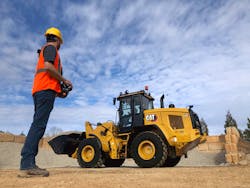Caterpillar Cat Command for Compaction is an operator-assisted technology that automates the soil-compaction process and assists in achieving compaction quality. The new system is available for use on select Cat vibratory soil compactors as a dealer installed kit on both new and existing B-Series machines.
An in-cab display uses a touchscreen interface, and the system connects to common base stations with no back-office or design needed, says Caterpillar. The operator uses the machine to map the boundaries of the area to be compacted and enters compaction parameters. Once the operator places the machine in “auto,” the system controls propulsion, steering, and vibration. Recent jobs are saved in the system and can be accessed through the touchscreen interface.
An integrated object-detection system alerts the operator if an object is in the pathway. If an area cannot be compacted using vibration, the vibration system can be switched off, then reactivated once the area has been passed. By automating the compaction process, says Caterpillar, operator skill gaps are minimized and consistent results can be achieved. Command for Compaction promotes compaction quality by maintaining constant speed, correct pass count, and consistent overlap, says the company.
Cat Command for Loading
Caterpillar also has extended the Cat Command for Loading system to several small wheel loaders (926M, 930M, and 938M). The system provides semi-autonomous, remote operation of the unmanned machine, thus increasing safety in potentially hazardous operating environments, says Caterpillar, such as stevedoring, steel mill blast furnaces, industrial and waste, demolition, and site decommissioning. The system is available in both line-of-sight and non-line-of-sight operating configurations
A dealer-installed field kit converts Cat 926M, 930M, and 938M wheel loaders to Command-ready. The system includes rear and side cameras, electric-over-hydraulic steering system, and the Command activation lever mounted on the machine for ground-level access. Installed on the cabin roof are cameras, indicator lights, microphone, wireless receiver, and antenna. Command controls are integrated with machine electronics, and machine response is identical to having an operator in the cab, says Caterpillar,
Line-of-sight Command uses a lightweight, compact control console supported by a shoulder harness. Basic machine controls (startup/shutdown, bucket rack/dump, and lift/lower) are accessed through the console. Commands from the remote console are sent directly to the engine and implement electronics via a detected radio. To ensure that the user maintains machine control at all times, the system’s integrated electronics stop all wheel loader movements if the A-stop or E-stop (emergency) switch is pressed, wireless communication is lost, severe fault is detected, or the console is tilted more than 60 degrees from normal operating position. Line-of-sight control extends up to 437 yards.
The non-line-of-sight Command for Loading system includes a modular, customized Command station that positions users in a seated position that simulates conventional machine control. One user can connect multiple machines from a single station, but can control only one machine at a time. The system also is compatible with other Command systems. At the jobsite, an optional remote All-Stop control is available for people working around non-line-of-sight Command loaders. Command for Loading for Cat 926M, 930M, and 938M wheel loaders will be available for purchase in late 2020.




